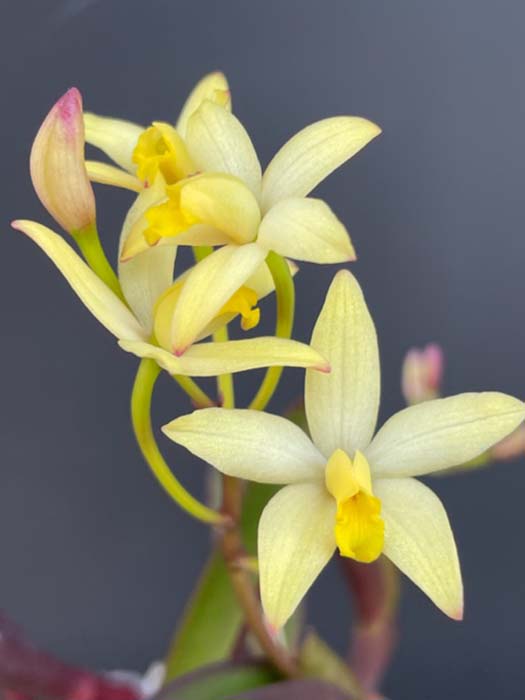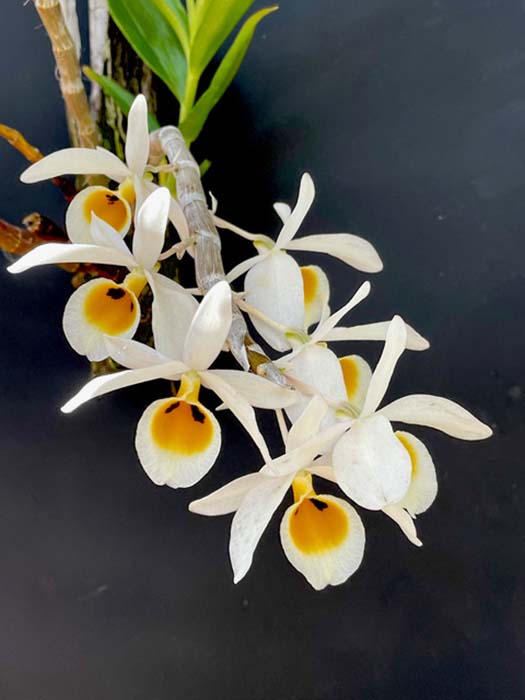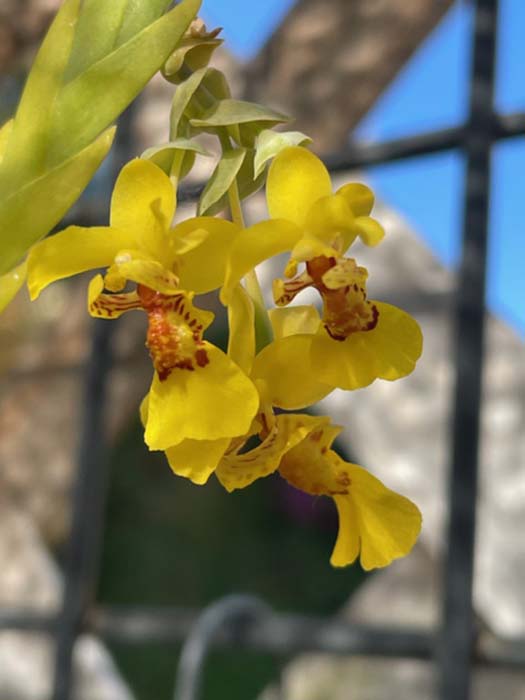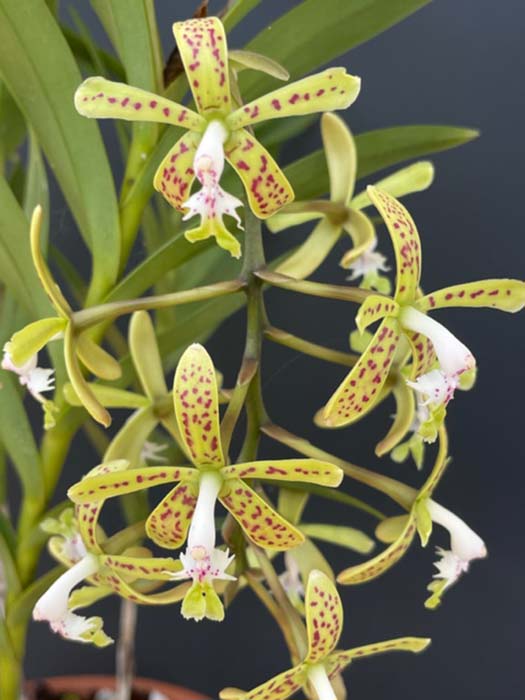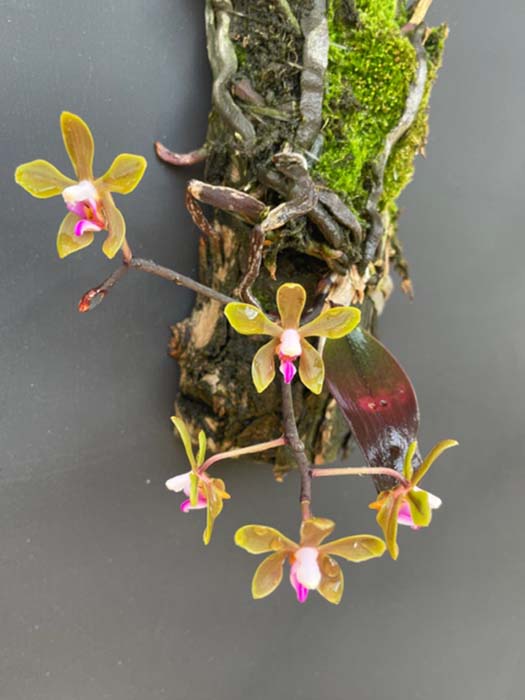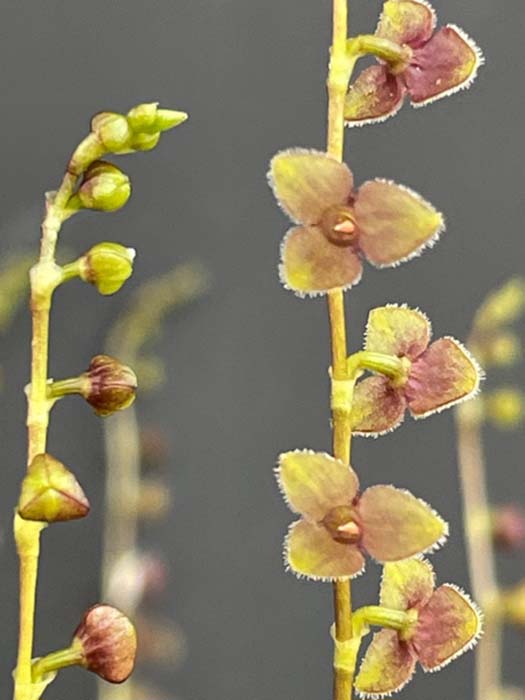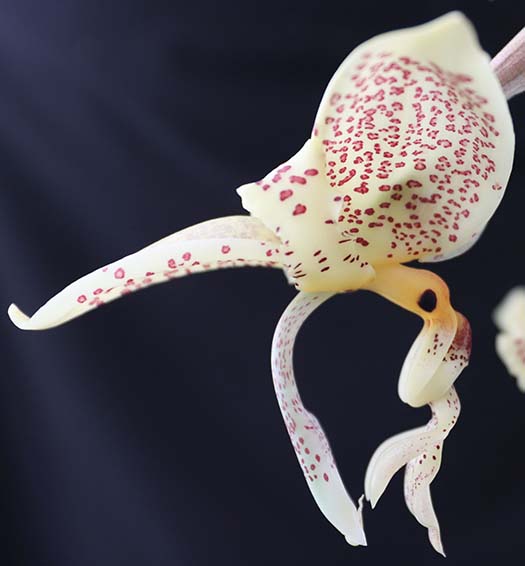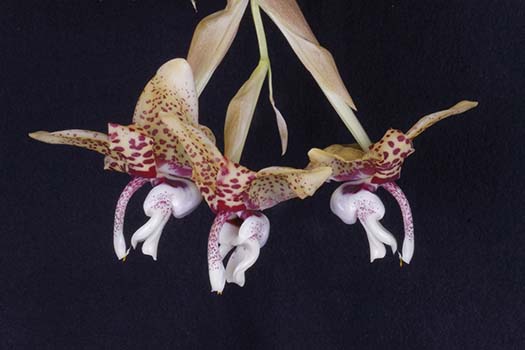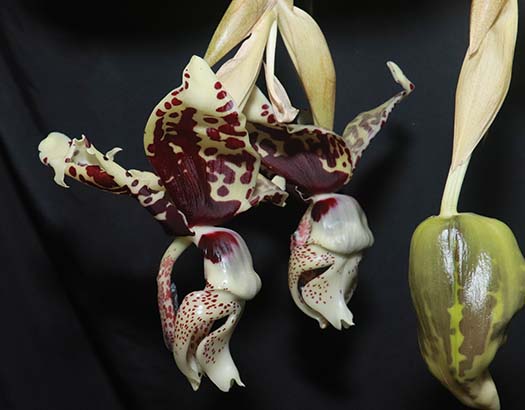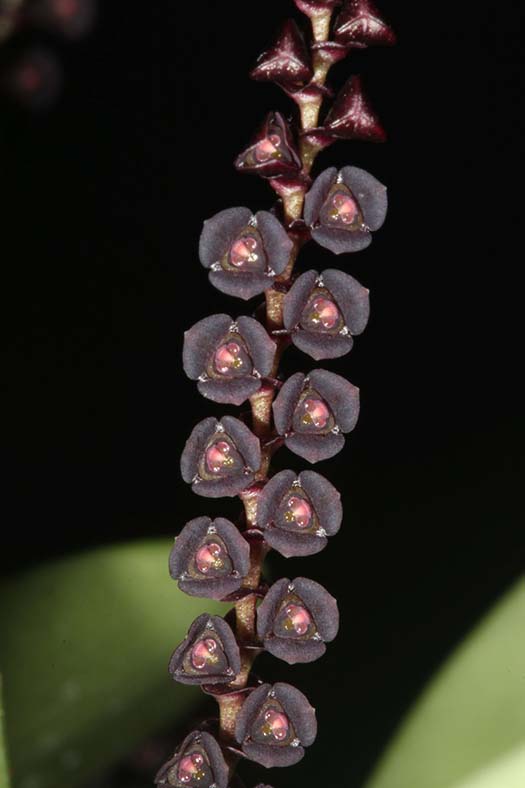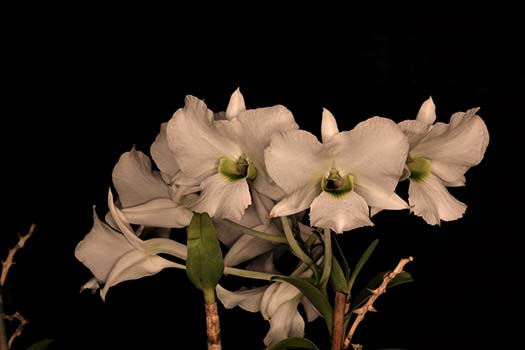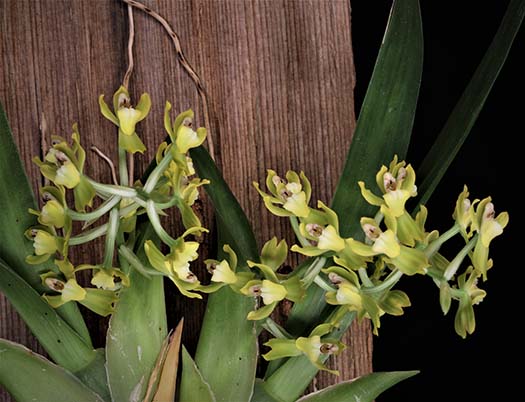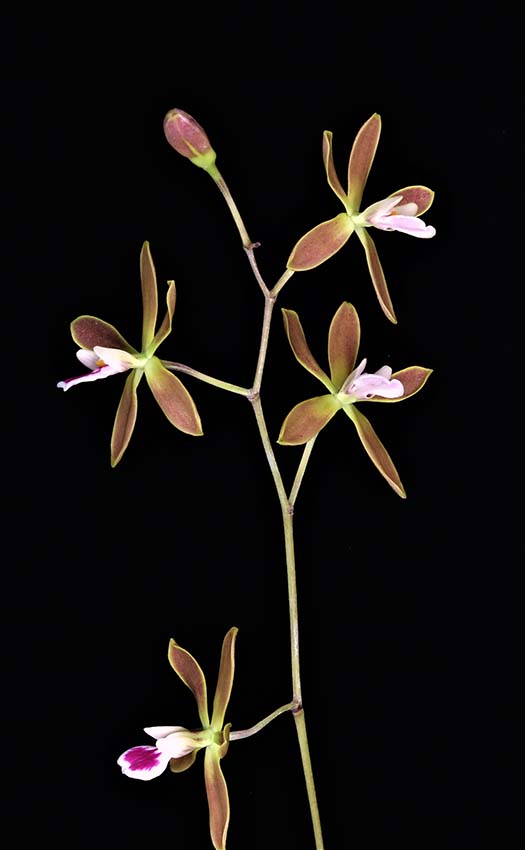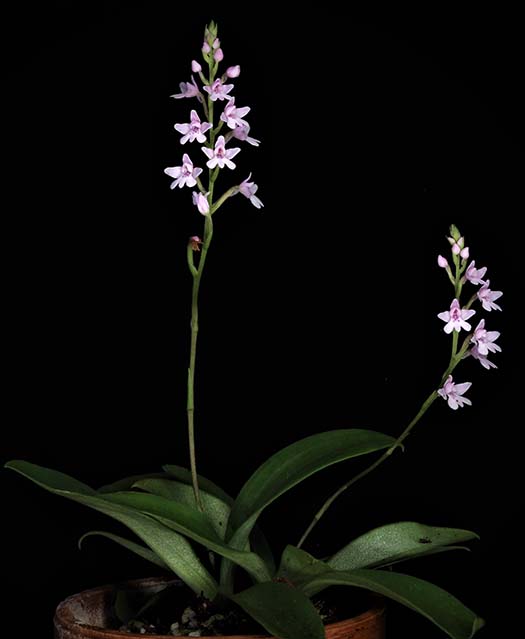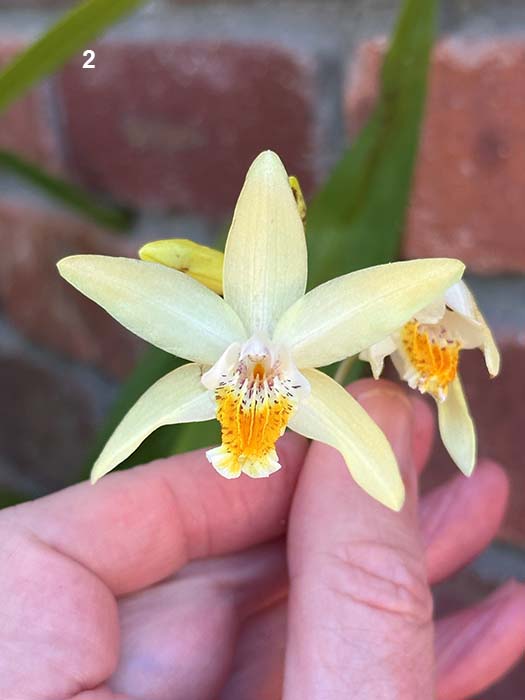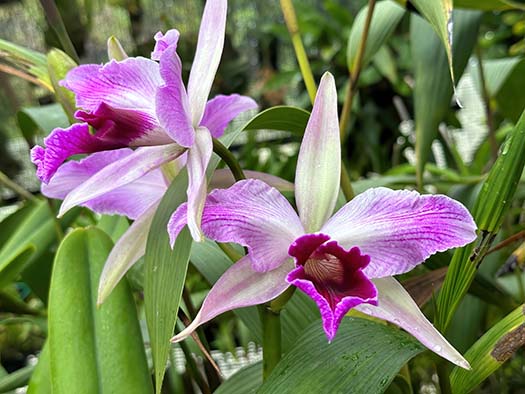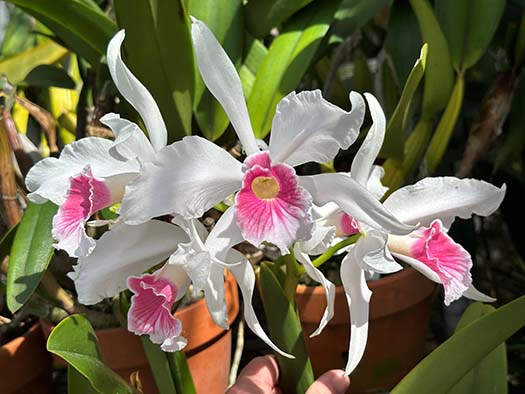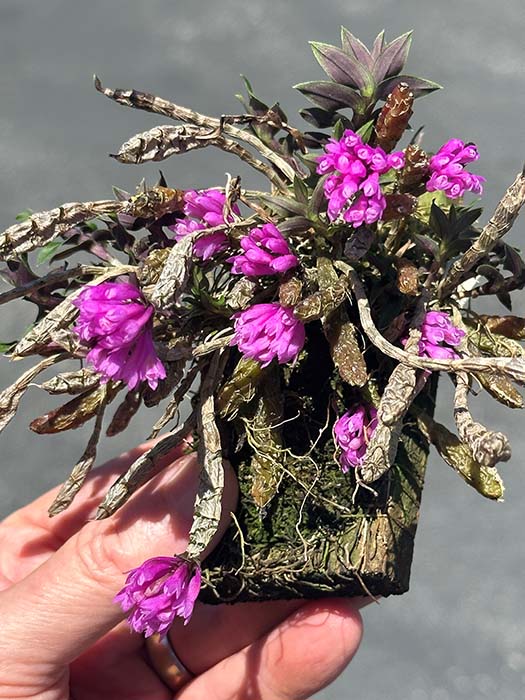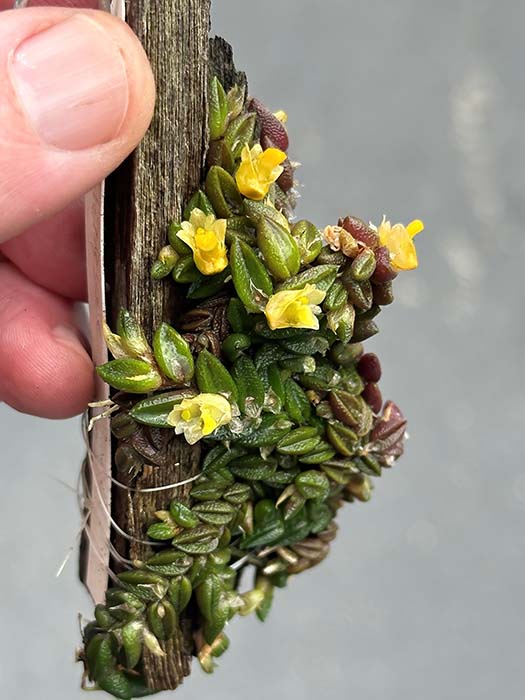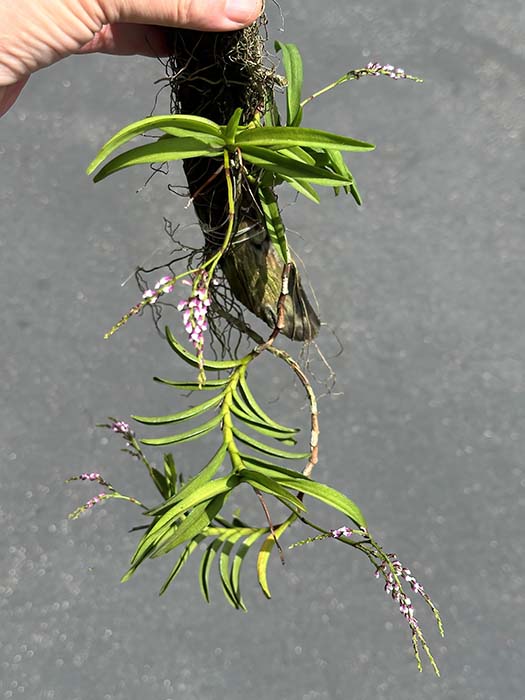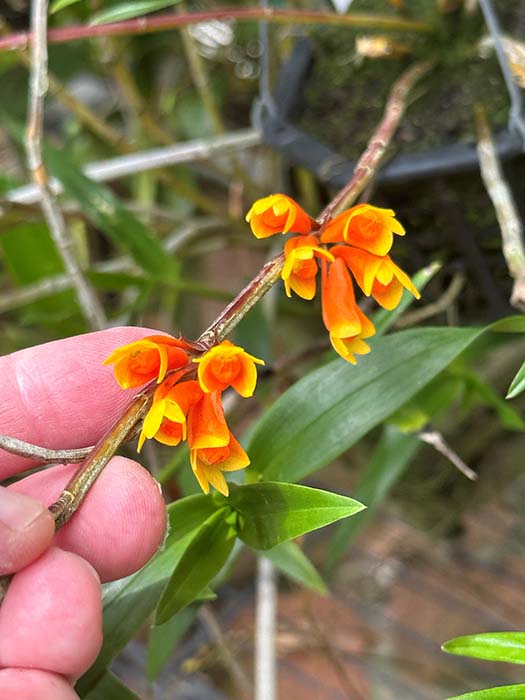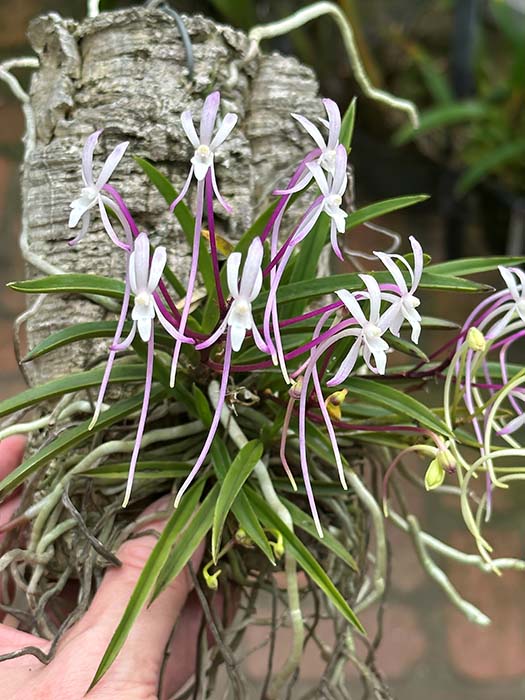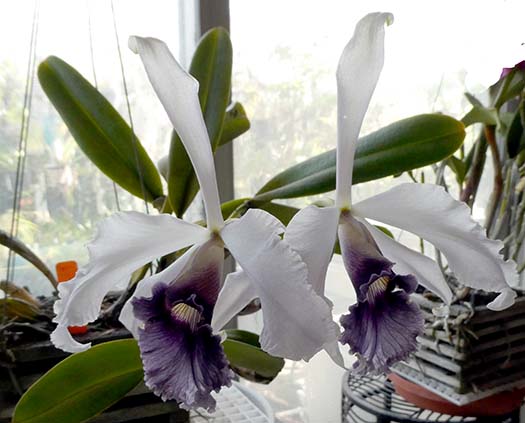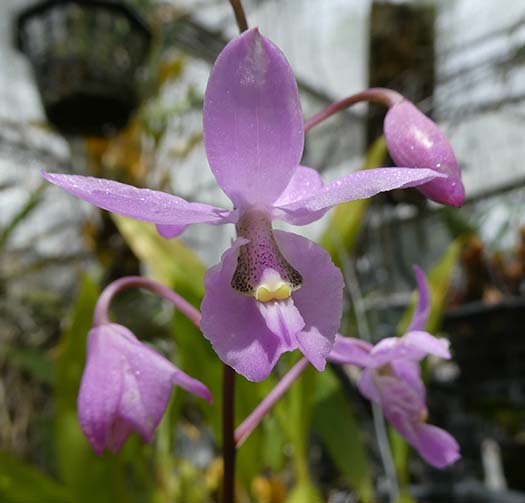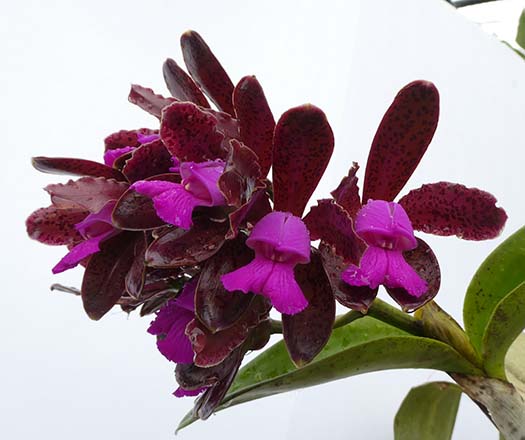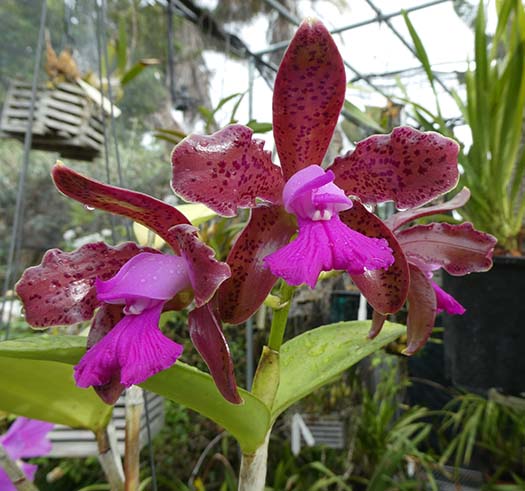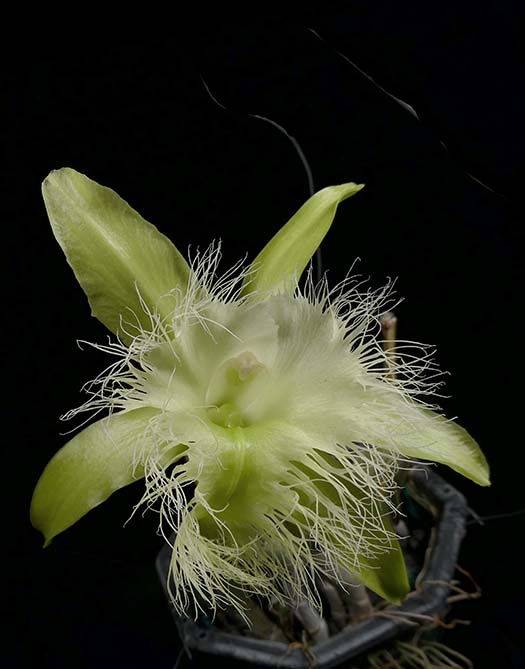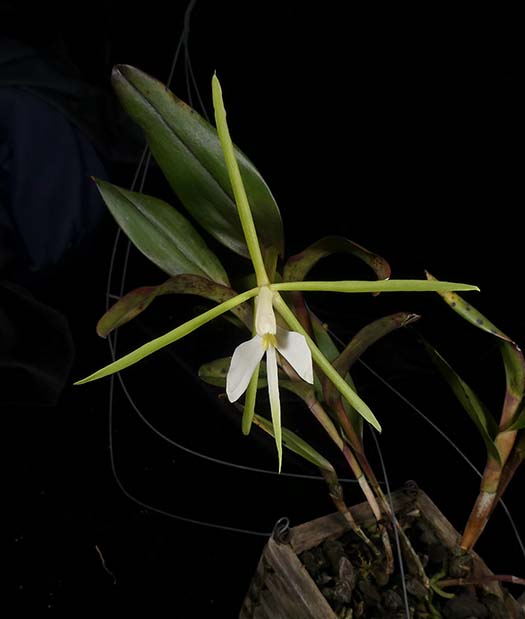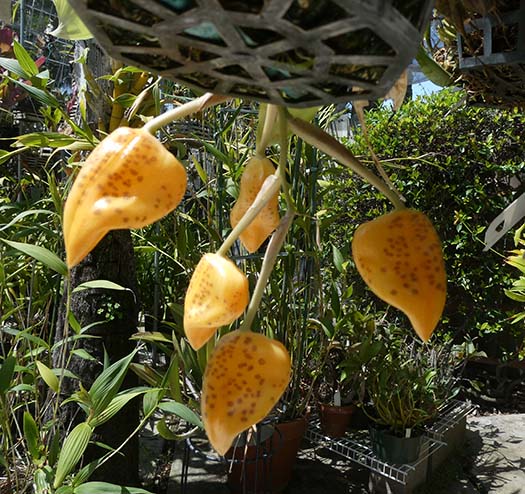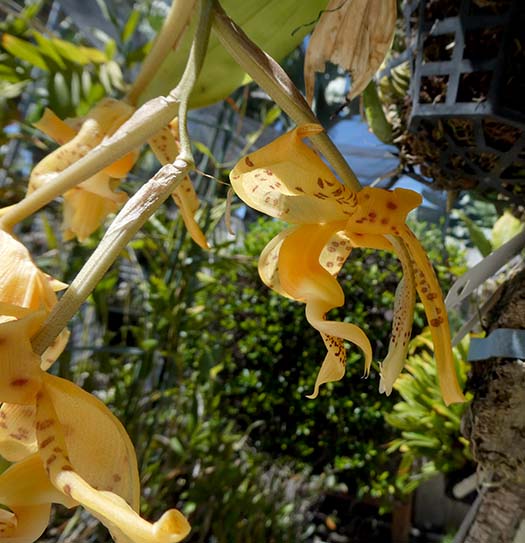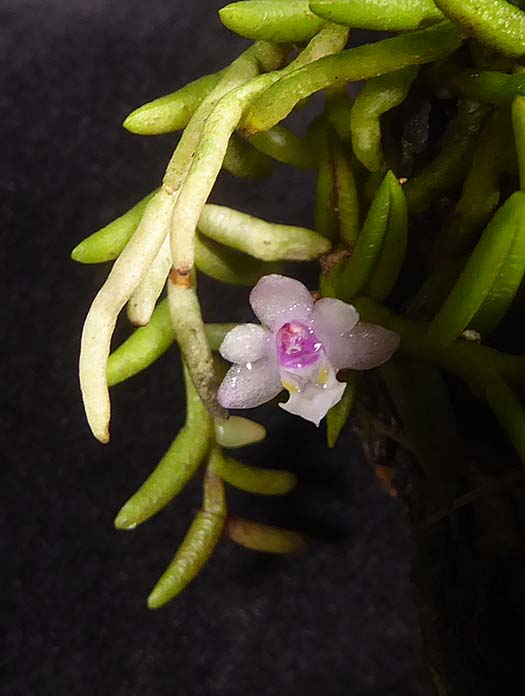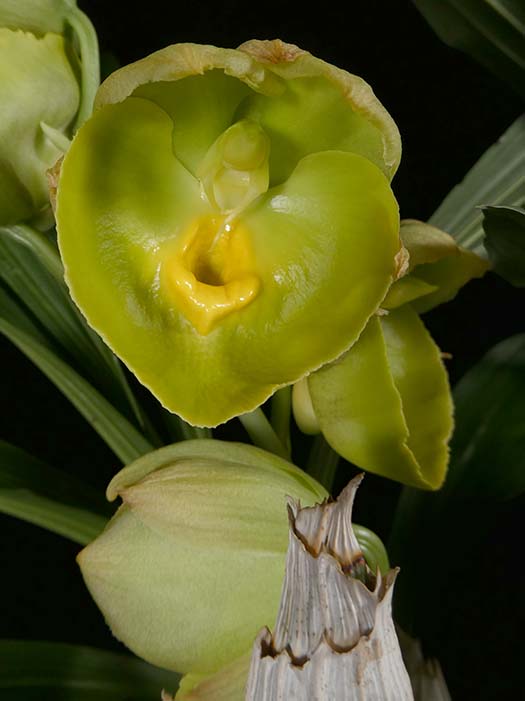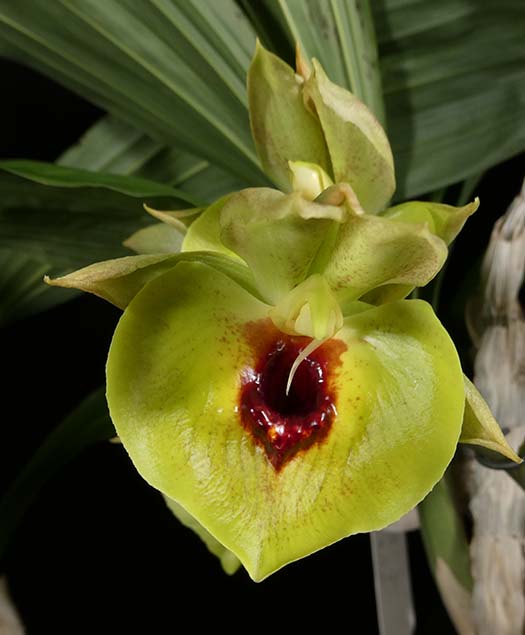September 2023
Scott has pointed out that every month we show glorious photos of our plants. Many are especially spectacular. Alas, some people may look at them with sadness, thinking of some of their plants that aren't doing so well.Fact is, no matter how much expertise any of us has acquired, nobody bats 1.000. The more orchids one grows, the more one appreciates the mortality of these fragile gems. So... this month, some of us are noting a few of our "dearly departed", and perhaps will learn what works for other people.(When you give cultural information about your blooming orchids, that helps those who might be struggling!) Also noteworthy is the choice to try again or not. (Personally, I usually quit after two failures unless I really like the plant and think I understand "why". Then, I try to at least quit after 3, though there have been a few exeptions to that "rule" too.) Roberta |
From Kurt Shanebeck:
|
|
Outdoors coastal, north of Los Angeles: |
|
 |
|
Epidendrum cristatumAn epiphyte or terrestrial species native to Mexico, Central America and South America. Growing potted in bark with moderately bright light. |
|
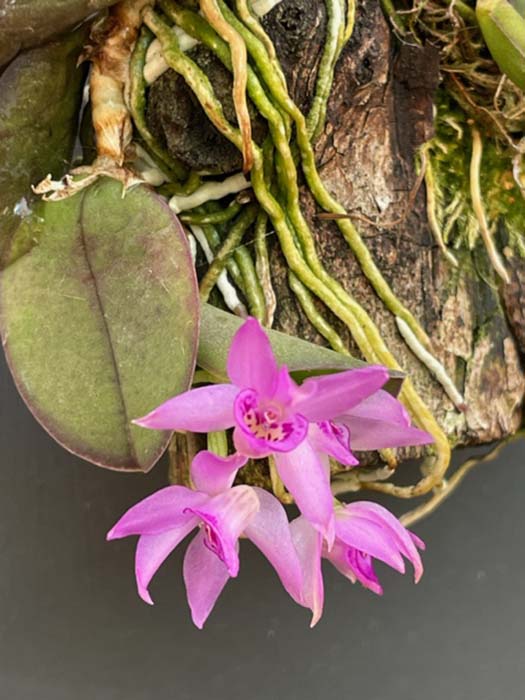
Meiracyllium trinasutumNative to Mexico and parts of Central America. Creeping growth habit with round leaves keeping fairly flat to the substrate. Growing mounted with bright light. |
|
Stelis sp.Unknown species of Stelis. Growing mounted, shady and moist. |
|
 |
Promenaea ovatilobaNative to Brazil. Growing mounted and moderately bright. |
From Chris Ehrler:
|
|
Coastal, California Central Coast |
|
Pleurothallis costancensisNative to Costa Rica and Panama at elevations around 650 to 1,800 meters. Is considered to be a hot to warm growing epiphyte, but is growing well a cool greenhouse mounted with some sphagnum moss on its root. |
|
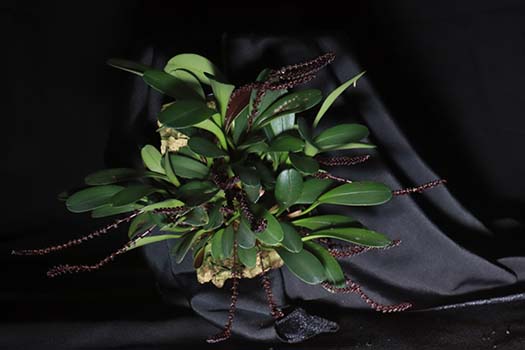 Stelis spp. (purple)Growing mounted to a piece of cork oak with some sphagnum moss on the roots. Mount is hanging in a cool greenhouse. |
|
Stelis spp. (yellowish)This unnamed Stelis was collected many years ago in Bolivia by an unknown collector. Growing mounted to a piece of cork oak with some sphagnum moss on the roots. Mount is hanging in a cool greenhouse. |
|
From James Lockman:
|
|
All plants grown outside, inland San Diego County, on a protected patio with 40% shade or more.
|
|
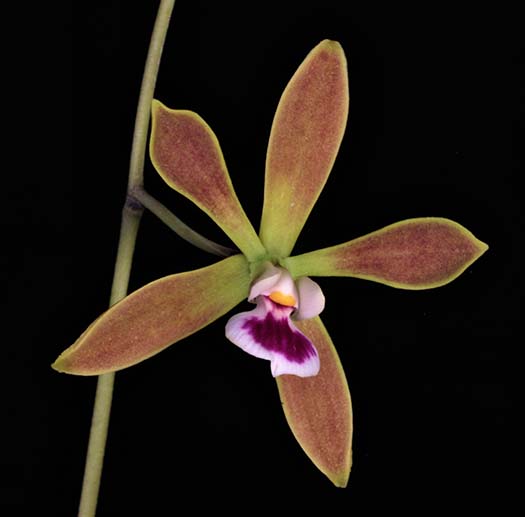 Encyclia tampensisThis form is native to Florida. Also occurs in the Bahamas. |
|
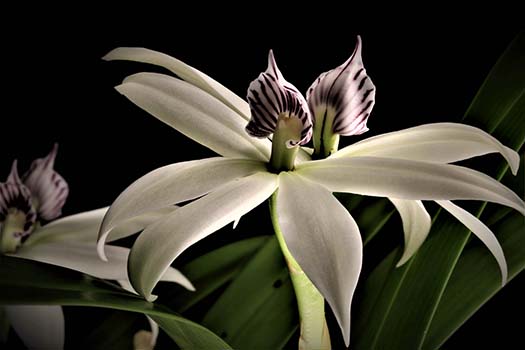
Prosthechea bacalusThis and the following species have previously been classified as Encyclia. Found in mid-elevation cloud forests in Panama. Flowers come in pairs on each inflorescence. It is the largest flowered Prosthecea that I grow, and among the most beautiful. Long lasting, strongly sweet-scented flowers. |

Prosthechea garcianaNative to seasonally dry forests in Venezuela. Easy to grow and prefers a drier winter. Moderately scented flowers are long-lasting, usually in pairs on several inflorescences. |

Prosthechea vespaNative to the cool Atlantic forests of eastern coastal Brazil up to 4,000 ft. One of the smaller flowered species but abundantly floriferous. This plant has five inflorescences this year. Slightly fragrant, very long lasting. Yes, I like this genus; more next month. |
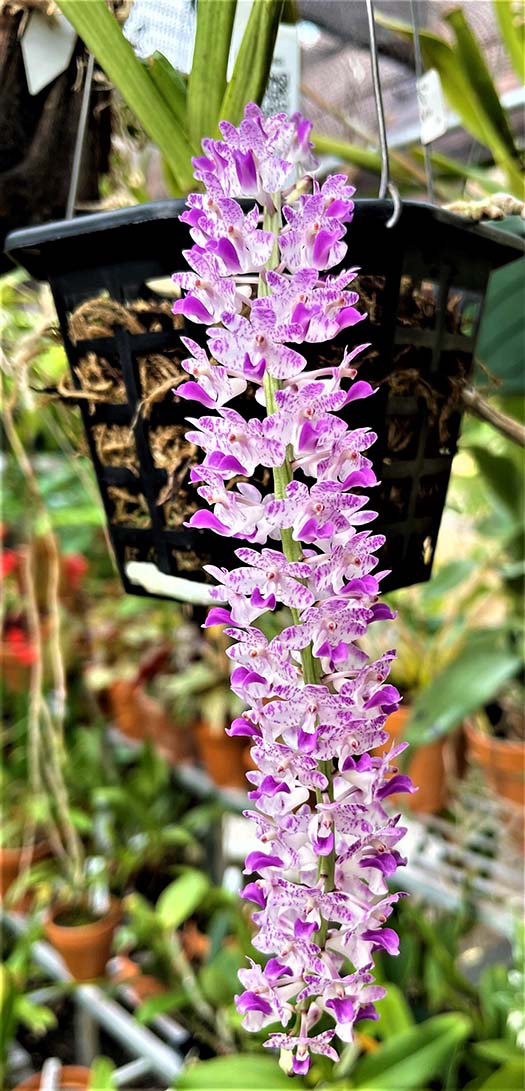
Rhynchostylis retusaI first saw pictures of this species in the Jones and Scully catalogs of the 1960’s and was enthralled with it. It would probably prefer warmer winters, but it and its relatives continue to survive in my sheltered outdoor growing environment |
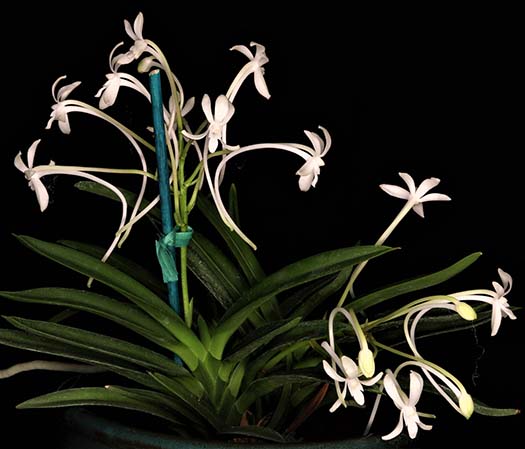
Vanda falcataWidely known as Neofinetia falcata. Much-loved throughout its East Asian range (China, Japan, southern Korea) and beyond. Grows as an epiphyte or lithophyte in deciduous forests at elevations 1.500 – 3,000 ft. This form is from the very south of Japan. |
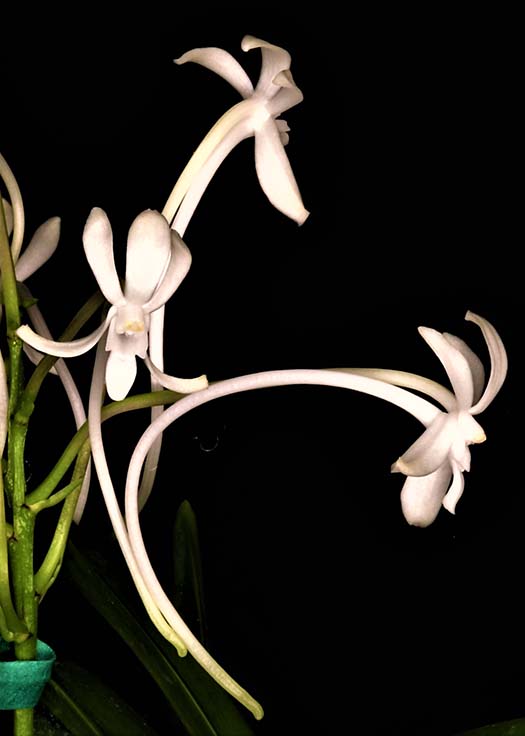 |
From Scott McGregor:All orchids grown outdoors, coastal southern California |
|||||||||||||||||||||||||||||||||||||||||||||||||||||||||
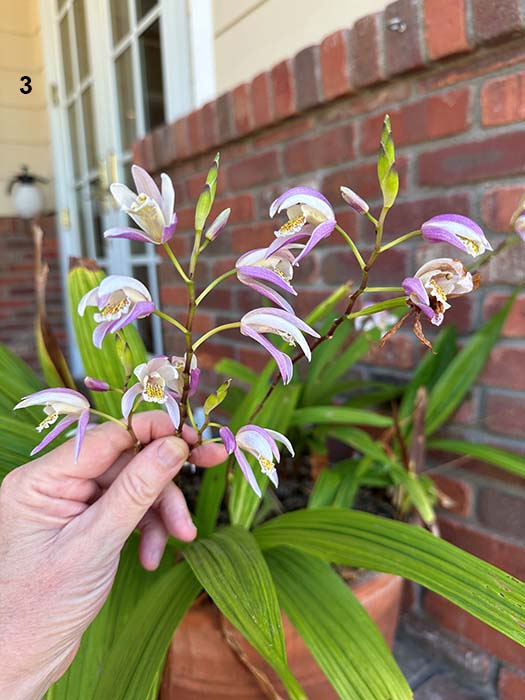 |
|||||||||||||||||||||||||||||||||||||||||||||||||||||||||
Bletilla ochracea, striata, and friendsBletilla is a small genus of deciduous, winter-dormant terrestrial species that grow very well outdoors and can handle snow, full sun and high heat. Bletilla ochracea is yellow but is often hybridized with B. striata to create pink forms. B. striata is typically purple, but also has an alba variety ‘White Pearl’. I have a large pot of mixed B. ochracea and a pink hybrid that stays in flower from May through September (pic 1). Pic 2 is a close-up of B. ochracea. Pic 3 & 4 are a pink B. ochracea hybrid, and Pic 5 is B. striata ‘White Pearl’. Unlike the long summer blooming season of B. ochracea and its hybrids, B. striata typically flush blooms in the spring. Examples of species and various hybrids for sale are here: https://www.plantdelights.com/collections/bletilla |
|||||||||||||||||||||||||||||||||||||||||||||||||||||||||
 Brassia verrucosaA great outdoor species that almost doubles in size every year. Nine spikes this time. |
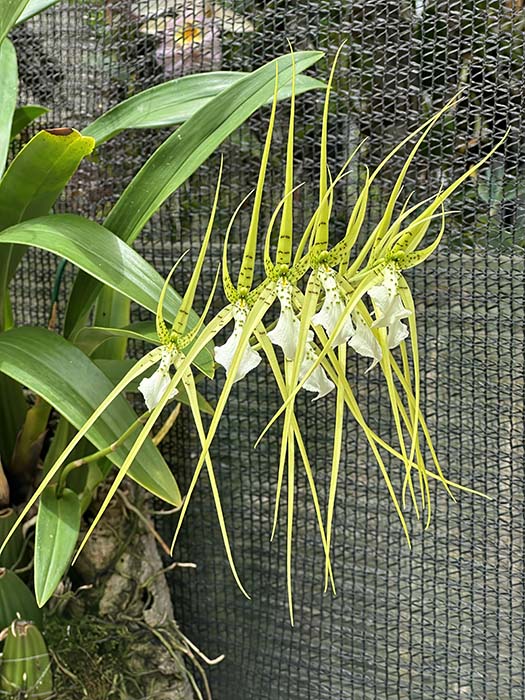 |
||||||||||||||||||||||||||||||||||||||||||||||||||||||||
Cattleya tenebrosa var aurea '#1' x 'Walton Grange' FCC/AOSLine-bred Cattleya (Laelia) tenebrosa, this variety with golden petals/sepals. |
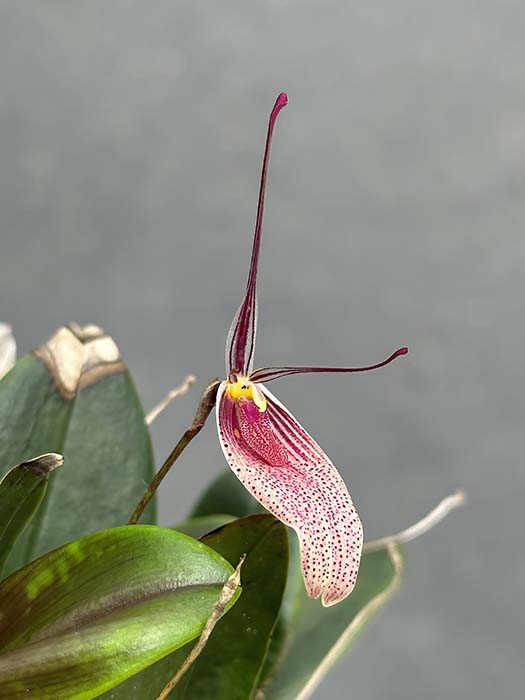
Restrepia chameleonSupposedly named for flower color variation, but seems most Restrepias do that! |
||||||||||||||||||||||||||||||||||||||||||||||||||||||||
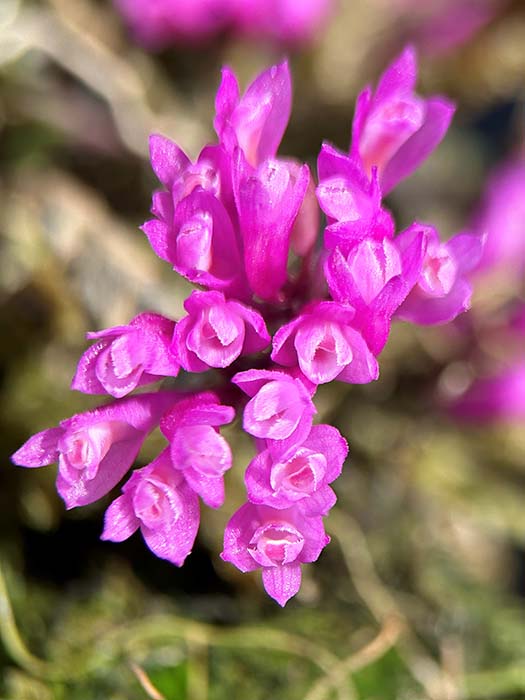 |
|||||||||||||||||||||||||||||||||||||||||||||||||||||||||
Dendrobium limpidum (dichaeoides fat bulbs)Small but colorful species from New Guinea that has grown outdoors happily on the same mount for ten years. |
|||||||||||||||||||||||||||||||||||||||||||||||||||||||||
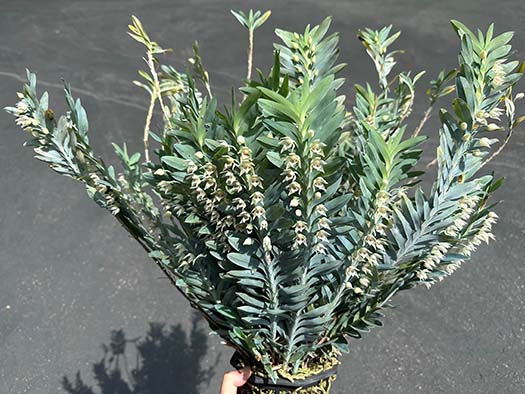 Dichaea glaucaMonster plant with ~60 canes, blooming on old and new canes, smelling intensely of cotton candy. The species is named for the structural bluish color in the leaves. |
 |
||||||||||||||||||||||||||||||||||||||||||||||||||||||||

Mormolyca ringensMaxillaria relative that blooms at various times. Single 1” flowers on thin 16” scapes. |
|||||||||||||||||||||||||||||||||||||||||||||||||||||||||
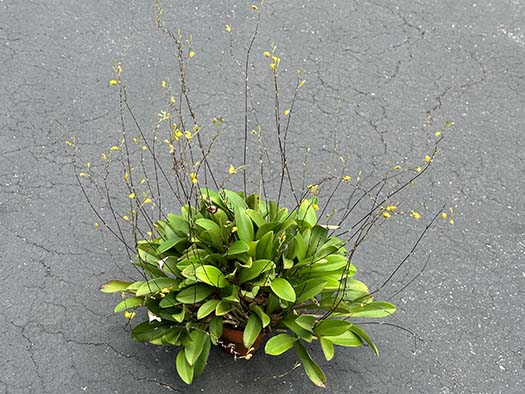
Scaphosepalum bicristatumOK, so the flowers ain’t much, but this one is in bloom all the time, with long flower spikes blooming sequentially for a year or more. Seems to happily grow into a specimen. |
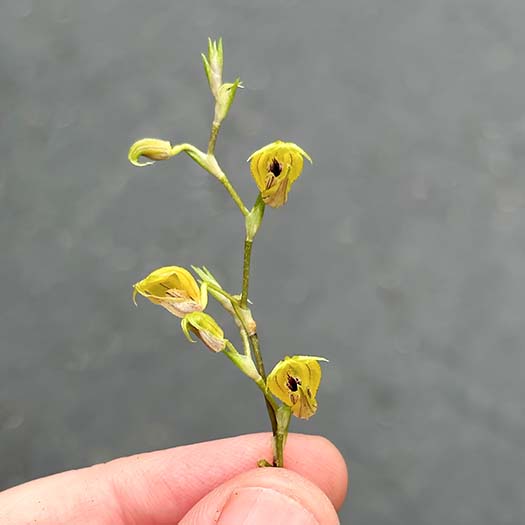 |
||||||||||||||||||||||||||||||||||||||||||||||||||||||||
 |
|||||||||||||||||||||||||||||||||||||||||||||||||||||||||
Schoenorchis gemmataA small vandaceous orchid with tiny flowers that open over a couple months. |
|||||||||||||||||||||||||||||||||||||||||||||||||||||||||

Sobralia xantholeucaA short-growing ruffled variety of S. xantholeuca. I’m always eager this cheerful one to open. |
|||||||||||||||||||||||||||||||||||||||||||||||||||||||||
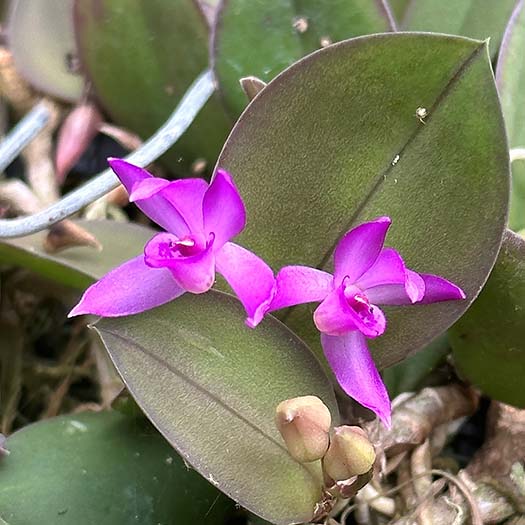
Meiracyllium trinasutumSmall-flowered species from Central America with cinnamon-scented flowers. Alba forms are also available. |
|||||||||||||||||||||||||||||||||||||||||||||||||||||||||
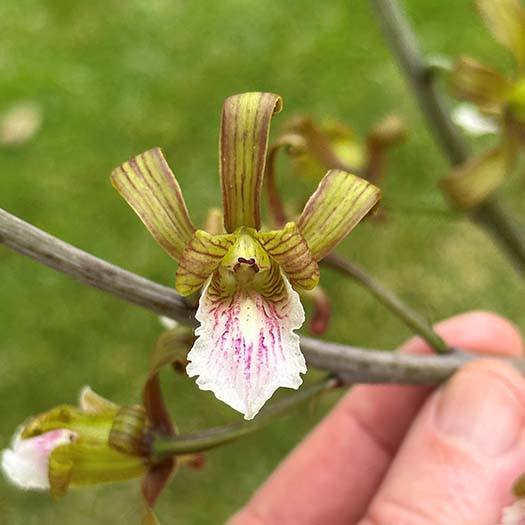
Eulophia petersiiNo greenhouse? Inland with temperatures frequently above 100F? Forget to water often? Don’t like to repot more than every five years? You’re in luck! This nearly indestructible species from Saudi Arabia and other arid regions of Africa likes “cactus culture”! |
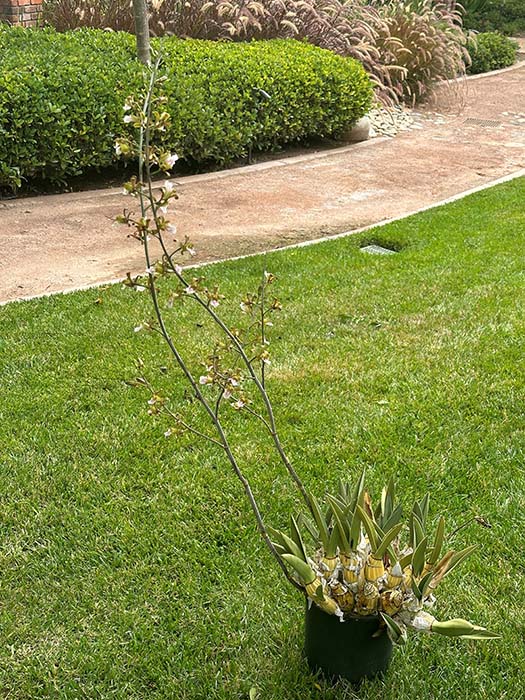 |
||||||||||||||||||||||||||||||||||||||||||||||||||||||||
Vanda (Neofinetia) falcata 'Shutenno' 朱天王One of my favorite Neo clones with dark pink accents. |
|||||||||||||||||||||||||||||||||||||||||||||||||||||||||
Dearly departed... |
|||||||||||||||||||||||||||||||||||||||||||||||||||||||||
|
|||||||||||||||||||||||||||||||||||||||||||||||||||||||||
From Roberta Fox:Coastal southern California |
|||||||||||||
Outside in the Back Yard: |
|||||||||||||
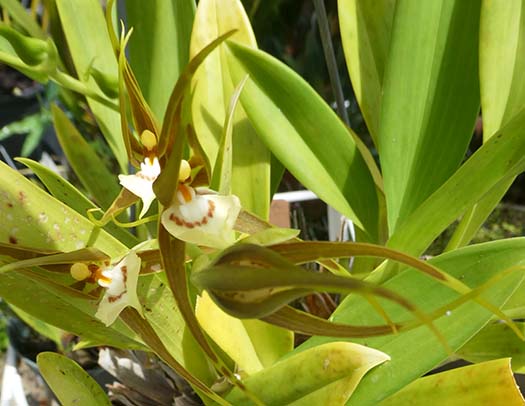
Brassia (Ada) glumaceaFlowers aren't dramatic to look at, but are extremely fragrant, reminds me of very ripe fruit. Some years, I don't notice the developing buds, then find it when I smell it. Native to Venezuela, Colombia, Ecuador, Peru, elevation around 1600 m. |
|||||||||||||
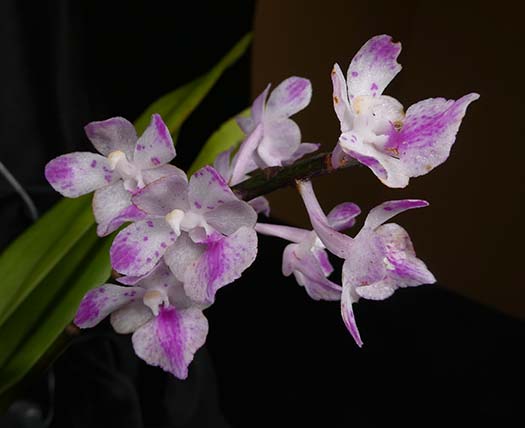
Aerides roseaNative to a wide area of east Himalaya, south-central China, northern India, and souteast Asia, 850-1500 m. |
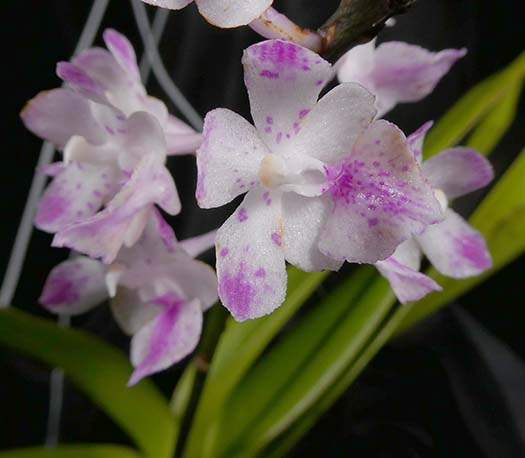 |
||||||||||||
Cattleya (Laelia) purpurata f. werkhauseriOne of the last of the purpuratas to bloom. This one has a dramatic, dark blue-purple lip. |
|||||||||||||
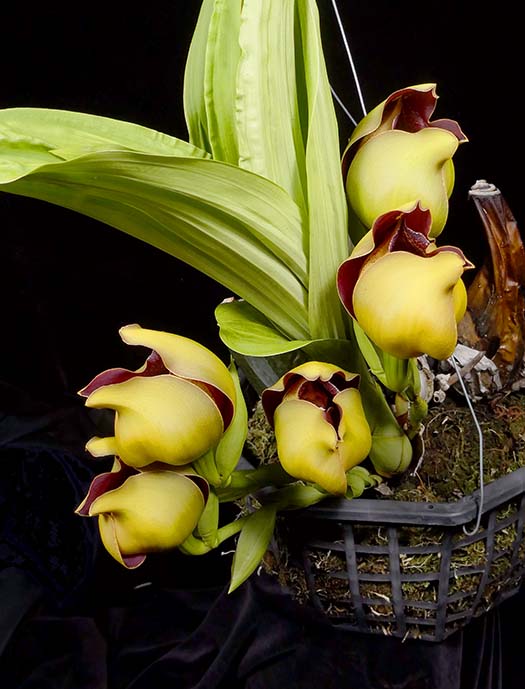 |
|||||||||||||
Anguloa brevilabrisThe "tulip orchid", this is as open as the flowers get. They are very fragrant. Native to Colombia and Peru, elevation 1000-1800 m. This is a big plant, with pseudobulbs about 5 inches tall by 3 inches wide. For me, it blooms about every two years. After it blooms, the new growth finishes developing and the pseudobulb matures. Eventually it loses its leaves, and just sits there for the next growing season, then produces new growth and flowers the season after that. |
|||||||||||||
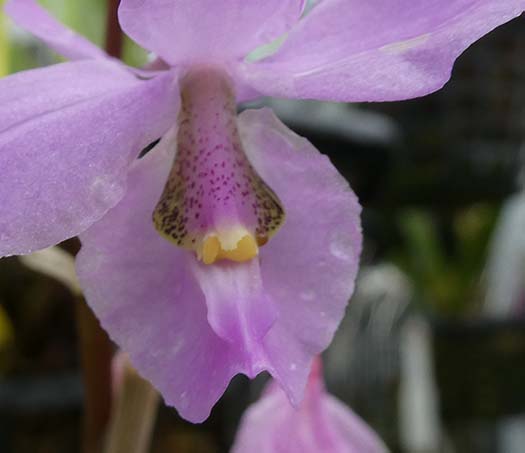
Barkeria melanocaulonI was afraid that I was going to lose this year's blooming when the tip of the newly developing spike broke, probably due to a perching bird. But it produced a new spike where it had broken, and bloomed after all. Native to Oaxaca in sousthwest Mexico, elevations 1400 - 2000 m. |
|||||||||||||
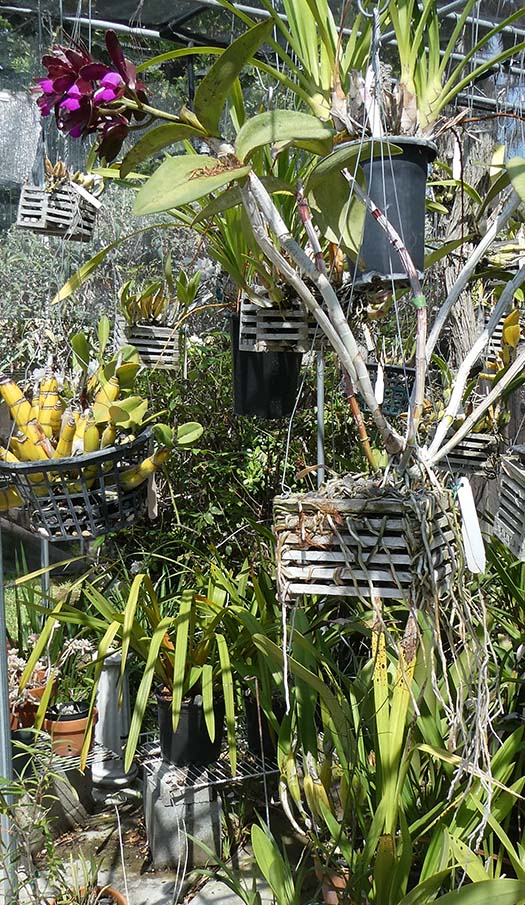
Cattleya tigrina (leopoldii)Here are two cultivars. The photo of the whole plant is the top one, just to show what a stately plant it is. . |
|||||||||||||
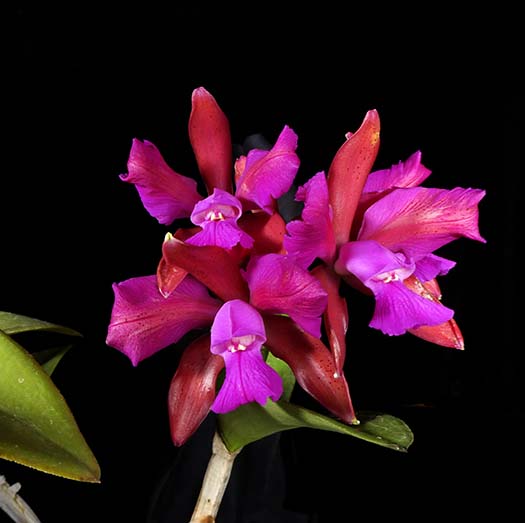
Cattleya tigrina (leopoldii) peloricThs one was labeled "coerulea" which it obviously isn't. But the hot magenta lip color is also visible in the petals, making a dramatic contrast with the chestnut base color. The typical spots are absent. |
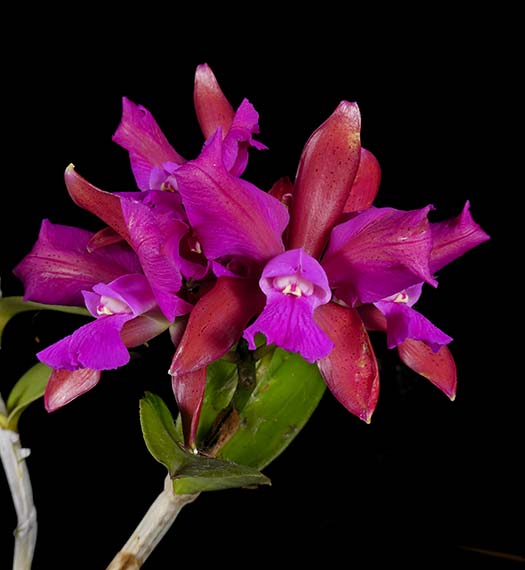 |
||||||||||||
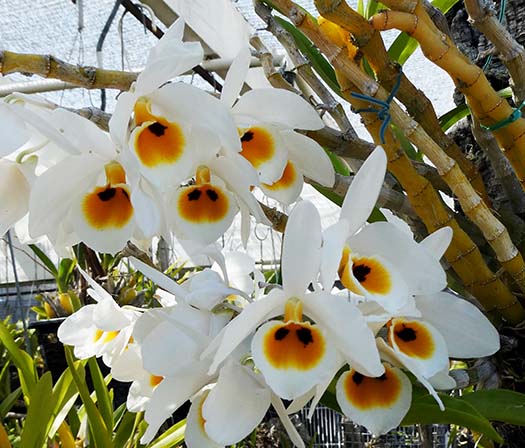
Dendrobium bensoniaeThis is one of the very few deciduous Dentrobiums that I do dry out in winter. It goes completely deciduous in the fall. In late spring (this year early summer) the buds start to develop on the leafless canes from the prior season, and new growth begins. This year, it didn't start to wake up until July! It is very fragrant. A bit like vanilla, or maybe more like angel food cake. Native to Myanmar, Thailand, and northern India, around 1520 m. It blooms only once on a cane, the older canes serve as the energy source for the plant through dormancy, and stay fairly firm and plump for 3 or 4 more years. |
|||||||||||||
 Dendrobium glomeratum (sulawesiense)This species supposedly is a low elevation warm grower, from New Guinea and the Molucca Islands. but it does fine outside for me. I wonder if there are different populations of the species, some from higher elevations. The orange lip contrasting with the hot magenta segments appears to almost glow in the sunshine. It can bloom repeatedly on old canes. |
|||||||||||||
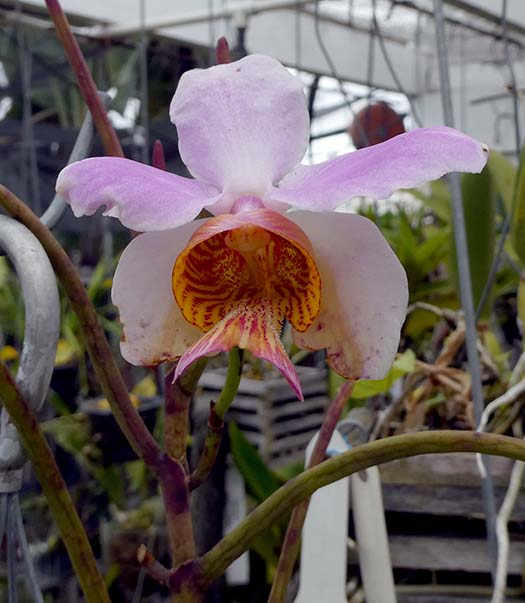 Papilionanthe teresThe genus was formerly "terete Vanda". It is native to a wide area of southeast Asia and Himalaya foothills, at a range of elevations. It likely would grow more vigorously with more warmth and humidity, but it does bloom and grow for me. I have some Tillandsia usenoides ("Spanish moss") around the roots for a bit of extra moisture. |
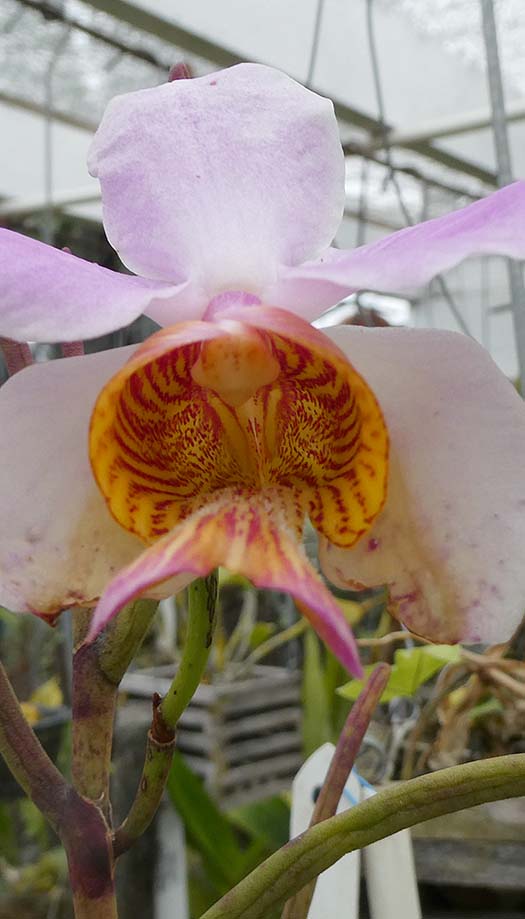 |
||||||||||||
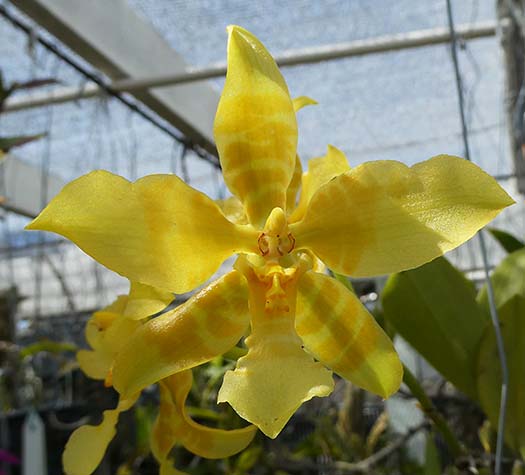
Rossioglossum schlieperianum f. aureaThe typical form has brown stripes on the sepals. There is still a bit of red pigment making the stripes visible, but much lighter. Native to Costa Rica and Panama, elevations 1200-1800 m. I grow it in basket with sphagnum, with bright morning light. |
|||||||||||||
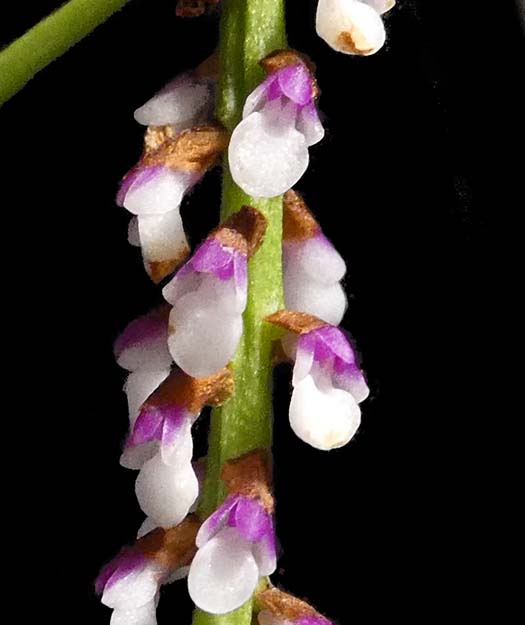
Schoenorchis gemmataTiny flowers (3-4 mm)that open sequentially. Leaves are semi-terete. It is native to a wide area of northern India, south-central China and southeast Asia over a range of elevations |
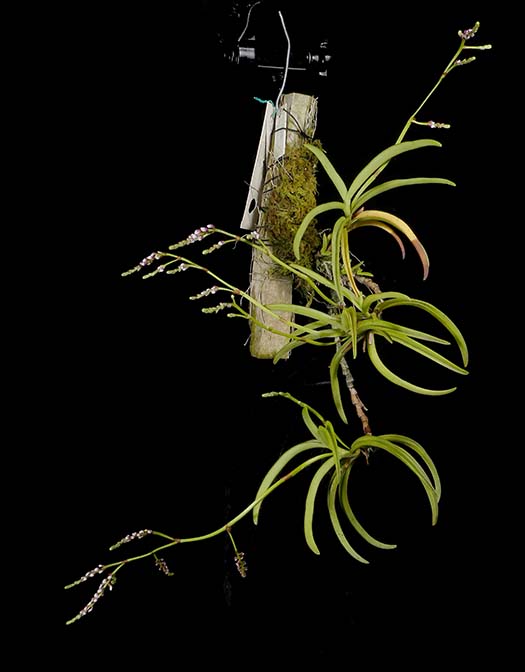 |
||||||||||||
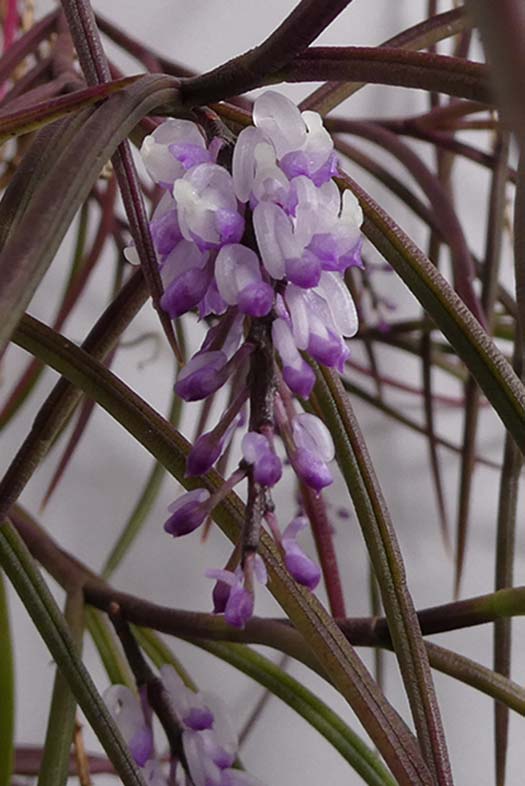
Schoenorchis juncifoliaFlowers are about 2-3 mm. The inflorescences look to me like tiny Wisteria. The species is native to Borneo, Java and Sumatra, elevations 500-2500 m. I grow it rather shady, but there still is plenty of light to get a lot of purple pigment in the terete leaves. |
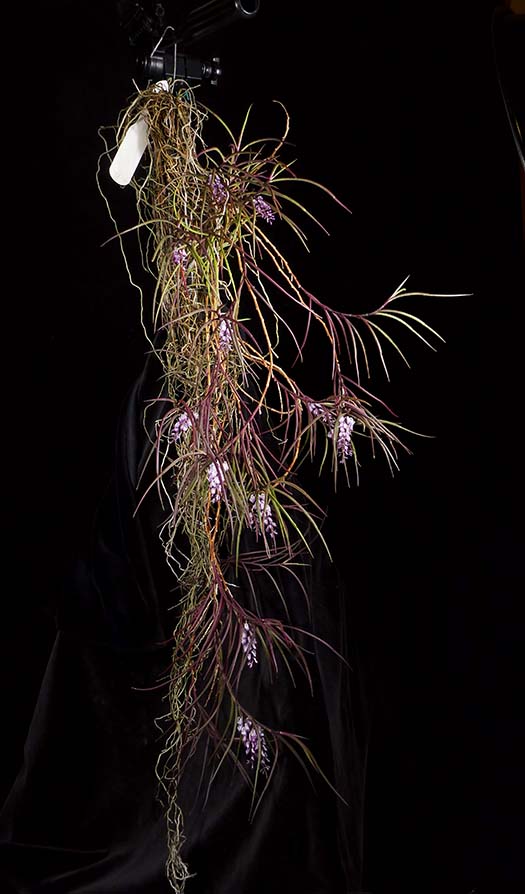 |
||||||||||||
 Stenoglottis woodiiNative to the Cape region of South Africa, elevation around 500 m. It goes dormant after blooming. I don't dry it out, and new growth starts fairly shortly after.
|
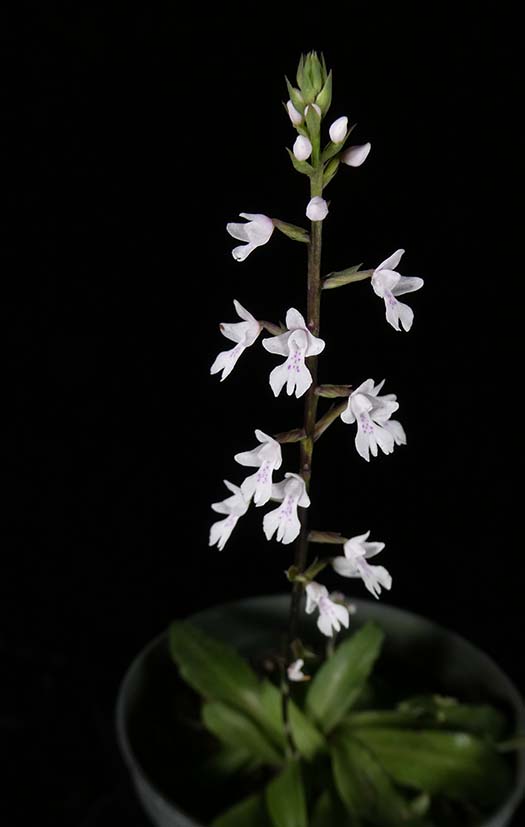 |
||||||||||||

Zygostates allenianaBrazil, Paraguay, Argentina. Exquisite little crystalline flowers on a 1 inch plant. |
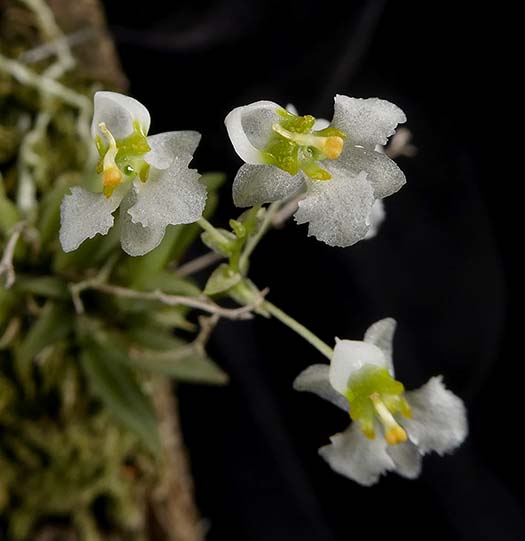 |
||||||||||||
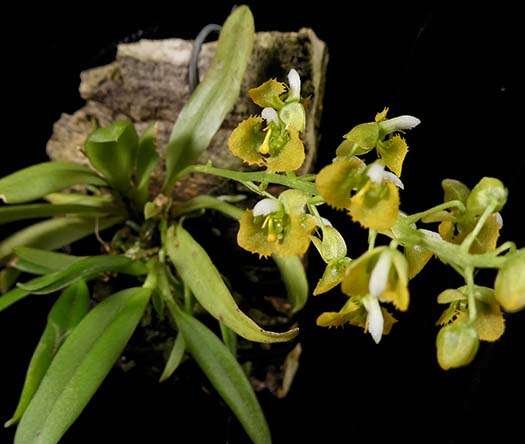
Zygostates lunataBrazil south and southeast. "Big" sister... plant is nearly 2 inches. Both of these look so tiny and delicate, but the flowers last nearly a month. |
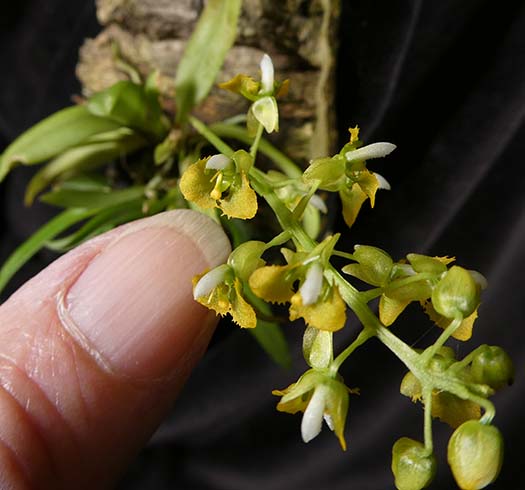 |
||||||||||||
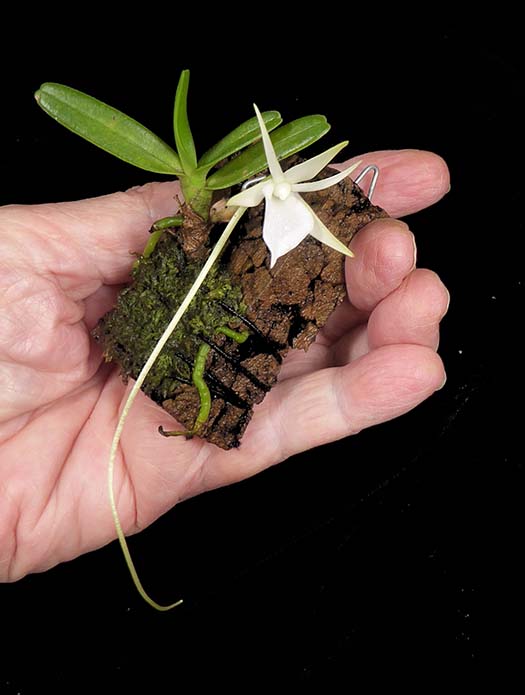 Angraecum breveFrom Madagascar, around 1800 m. Great flower-to-plant ratio. Night-fragrant and VERY cute. |
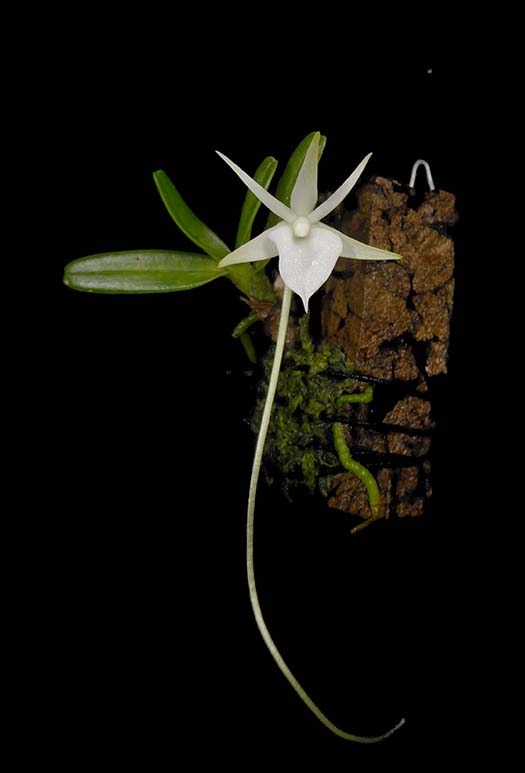 |
||||||||||||

Angraecum calceolusA truly tiny flower. This one is native to Madagascar and surrounding islands, at a range of elevations. Plant is about 3 inches (so big relative to the flower), and also produces a clump of basal growths, so I expect that as it matures there will be more flowers simultaneously. |
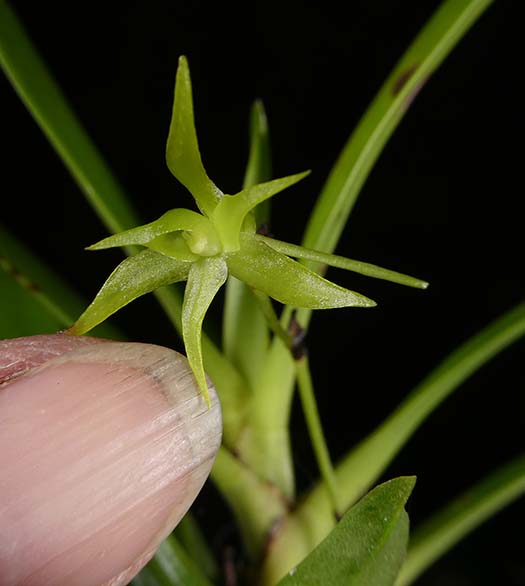 |
||||||||||||
Epidendrum nocturnumNight-fragrant species occurs on both sides of the Andes, at a variety of elevations. (I have seen it in Ecuador at medium elevations, and along the Rio Negro in the very tropical Amazon basin in Brazil). |
|||||||||||||
 |
|||||||||||||
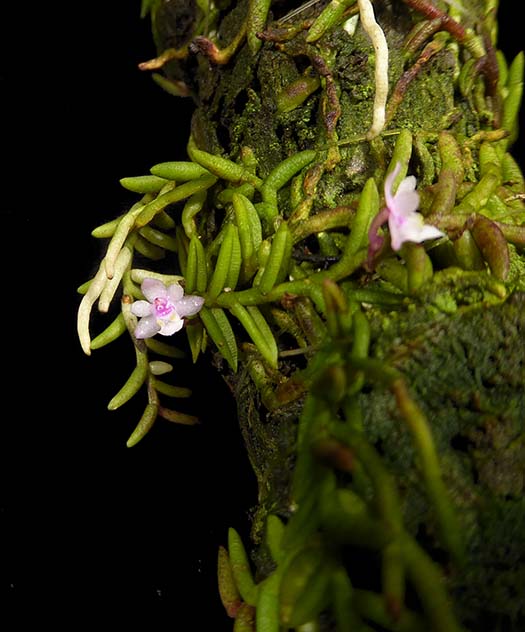 Cleisostoma scolopendrifolium
|
|||||||||||||
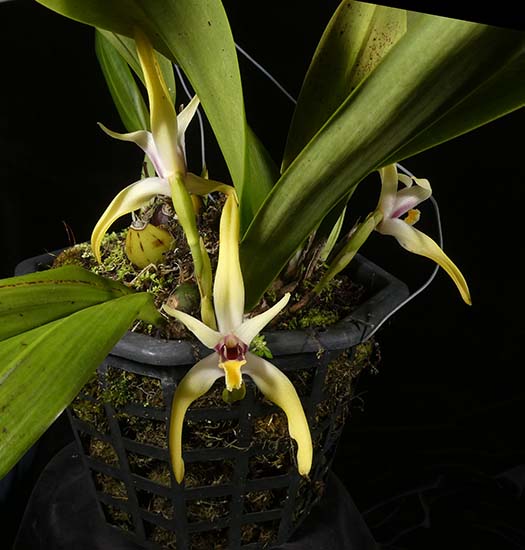
Maxillaria dilloniiFlowers are waxy and relatively long-lasting. The plant stays fairly compact. Native to Peru, elevation around 800 m., also found in Ecuador. |
 |
||||||||||||
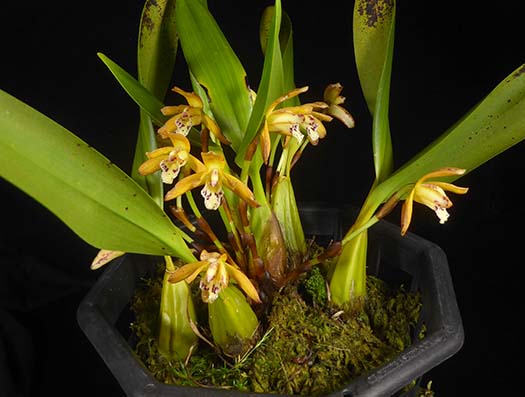
Maxillaria phoenicantheraThis is a very vigorous plant, and it does NOT stay compact. Last spring I divded it and that does not seem to have slowed it down at all. It is related to Max. picta (a spring bloomer). Native to southern Brazil, about 800 m. |
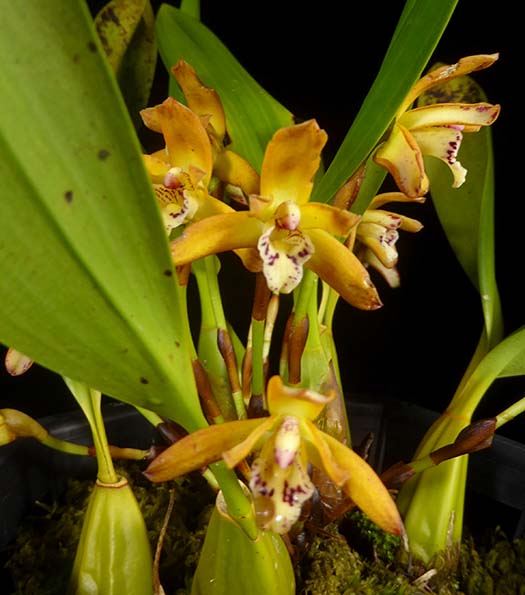 |
||||||||||||

Neofinetia (Vanda) falcata 'Kohkakuden' 紅嚇殿Most taxonomists consider the pink and purple Neofinetia falcata varieties to be hybrids (natural or otherwise) but any records are lost in time and in Japan, all are treated as the species. This one has intense purple color throughout the inflorescence. My plant is grown in an 8 inch plastic basket with sphagnum, roots happily extending out in all directions. |

Neofinetia (Vanda) falcata 'Amami Island'This variety, from southern Japan, has relatively large flowers for the species. Like all of them, fragrance is lovely, especially at night but some during the day too. I got this plant in a 6 x 6 inch plastic pot, roots all around the outside. There was no way to repot it without damaging roots, so I didn't. I assume that there is little or or no medium inside the pot after many years, but some of the roots on the outside have grown into the holes, so there must be an enviromment that they like. The root mass is also tangled up with some "Spanish Moss" (Tillandsia usenoides) that also grows vigorously. This plant is pretty much ignored except for annualy trimming spent spikes. And it thrives. |
||||||||||||
In the greenhouse... |
|||||||||||||
Catasetum expansumAlba and red formsUsually by mid-June, most of the Catasetinae are in rapid growth, and outside. This year, it was still cold and gray, and quite a few were still in the greenhouse, growths slow to mature but already in spike. Ctsm. expansum is my most robust species. Now it's warm enough for them to move outside. I see the start of another spike on the alba one, I expect another set of blooms in the fall. |
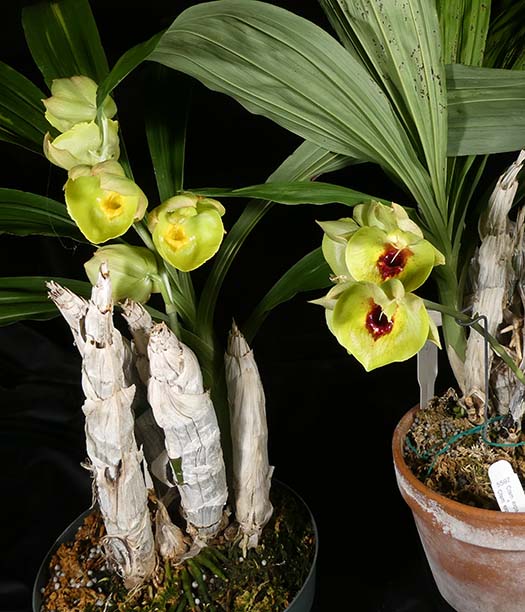 |
||||||||||||
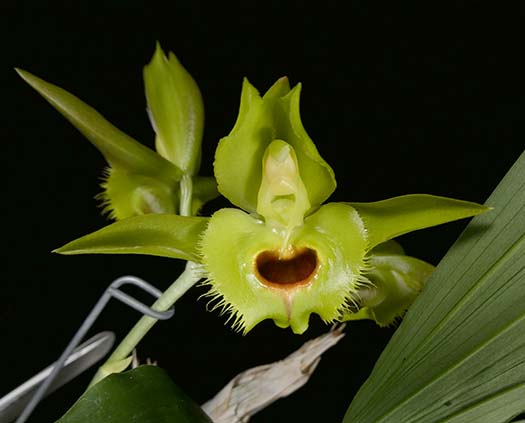 Catasetum osculatumAnother one that spiked while new growth was still developing.
|
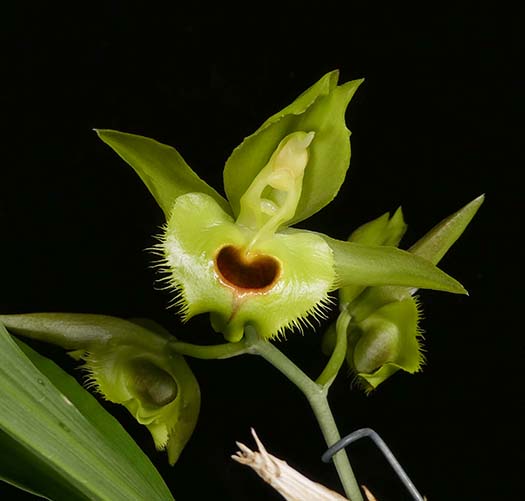 |
||||||||||||
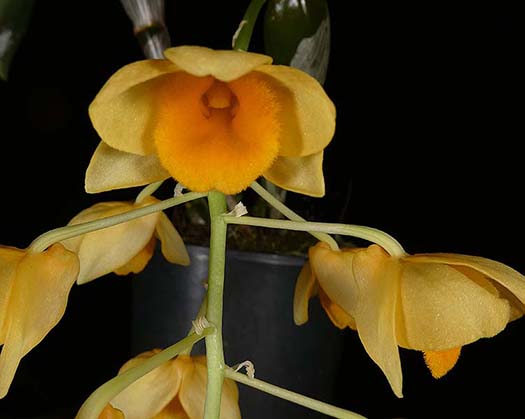
Dendrobium griffithianumI'm not sure why I decided, when I got this at an auction several years ago, that it needed to grow warm. It is native to northern India and souteast Asia at about 500 m, so perhaps more intermediate than cool. However, it shares habitat with quite a few species that I successfully grow outside, so it's moving out to stay.
|
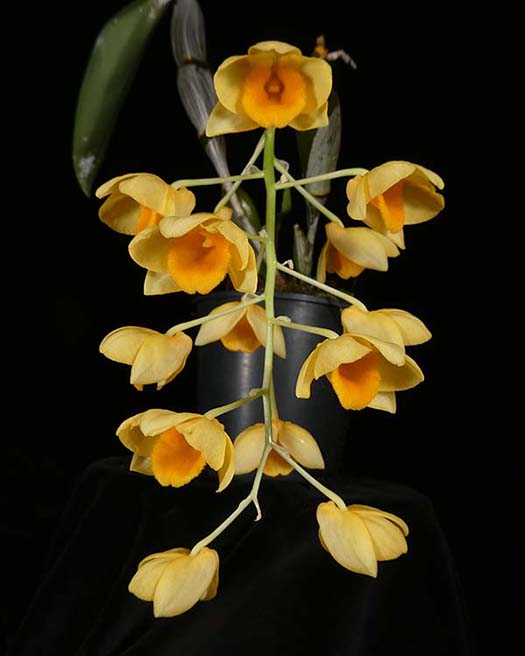 |
||||||||||||
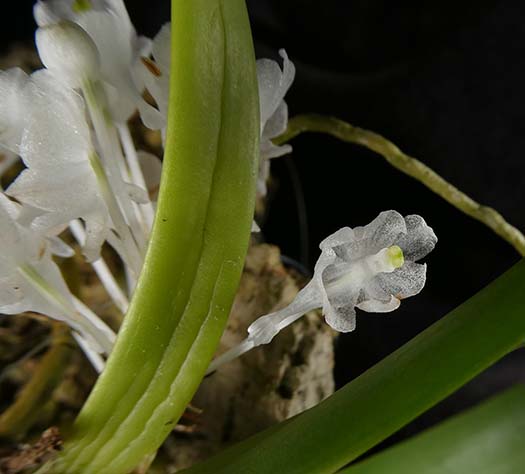 Podangis dactylocerasFrom tropical west Africa. Elevation range given on the Baker Culture Sheet, up to 1500 m, would indicate that it could grow cool. I have tried one outside, but it did not survive. This species does seem to need the warmth of the greenhouse. Flowers are crystalline and translucent. |
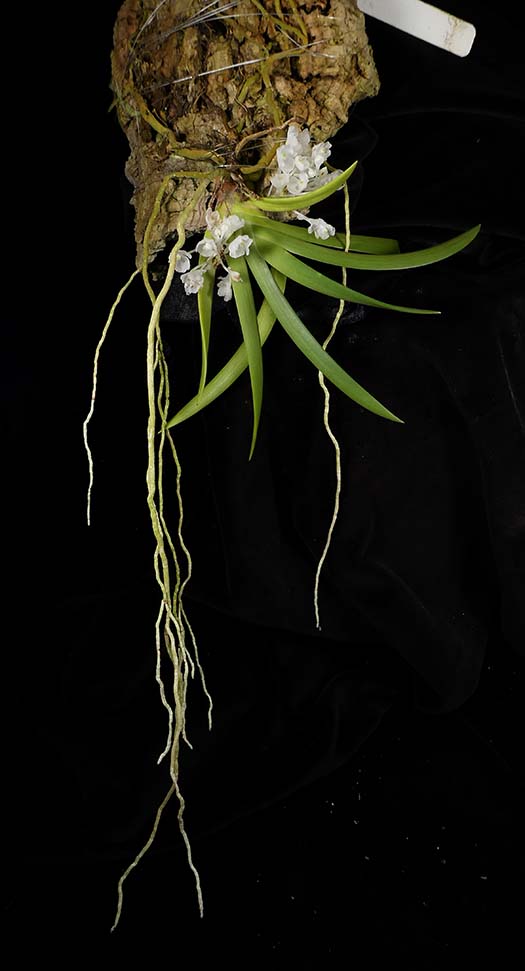 |
||||||||||||
 1.jpg) |
 2.jpg) |
||||||||||||
Habenaria erichmichaelii (rhodocheila 'Cardinal's Roost')Hab. erichmichaelii has been lumped into rhodocheila by some taxonomists, but others are convinced that there characteristics (beyond color) that make it a distinct species. Hab. rhodocheila comes in a range of color forms from deep red to orange to yellow. This one is certainly different. The genus goes completely dormant in the fall, to re-emerge in the spring. This one has bronze leaves that slowly turn green as the flowers mature, but on this plant there is still a lot of brown, with interesting pattern, still visible. These need to be moderately dry during dormancy, but I give it light watering every week or two through the winter, then start more thorough watering in late March or easly April, which seems to stimulate it into active growth. |
|||||||||||||
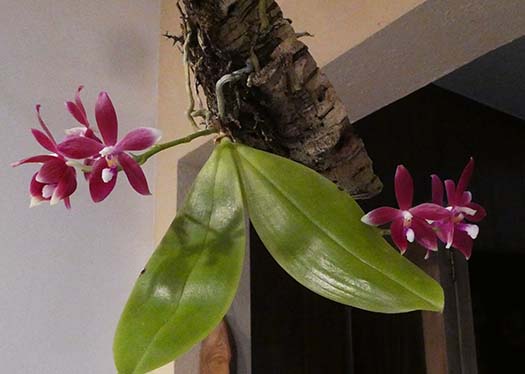
Phalaenopsis speciosaNative to Sumatra, and the Andaman and Nicobar islands. Flowers have heavy substance. An inflorescence can continue to produce new flowers over months or even years. Some flowers have white tips on the petals. It is closely related to Phal. tetraspis, or may be synonymous. |
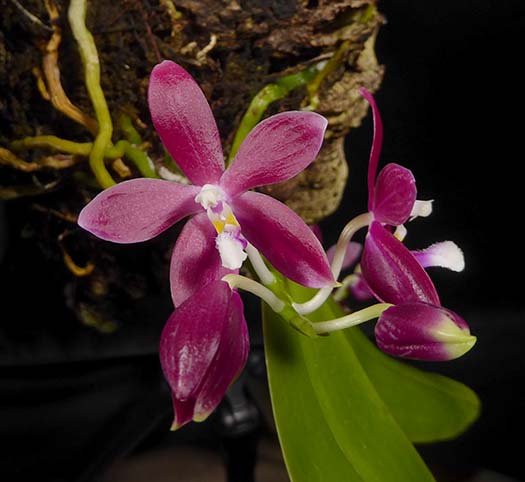 |
||||||||||||
Dearly departed...While fatalaties are inevitable, especially when trying new things and pushing the envelope on conditions, some hurt more than other. Especially, those plants that have done well for a long time, and then just go belly up. I have a few...And a few others of note. Can't list them all. |
|||||||||||||
|
|||||||||||||

